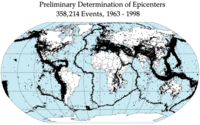
Photo from wikipedia
Abstract The characteristics of rock instability precursors and the principal stress direction are very crucial for the prevention of geological disasters. This study investigated the qualitative relationship between rock instability… Click to show full abstract
Abstract The characteristics of rock instability precursors and the principal stress direction are very crucial for the prevention of geological disasters. This study investigated the qualitative relationship between rock instability precursors and principal stress direction through wave velocity in rock acoustic emission (AE) experiments. Results show that the wave velocity variation exhibits obvious anisotropic characteristics in 0–20% and 60–90% of peak strength due to the differences of stress-induced microcrack types. The amplitude of wave velocity variation is related to the azimuth and position of wave propagation path, which indicates that the principal stress direction can be identified by the anisotropic characteristics of wave velocity variations. Furthermore, the experiments also demonstrate that the AE event rate and wave velocity show quiet and stable variations in the elastic stage of rock samples, while they present a trend of active and unstable variations in the plastic stage. It implies that both the AE event rate and wave velocity are effective monitoring parameters for rock instability. The anisotropic characteristics of the wave velocity variation and AE event rate are beneficial complements for identifying the rock instability precursors and determining the principal stress direction, which provides a new analysis method for stability monitoring in practical rock engineering.
Journal Title: International Journal of Mining Science and Technology
Year Published: 2021
Link to full text (if available)
Share on Social Media: Sign Up to like & get
recommendations!